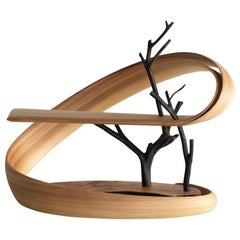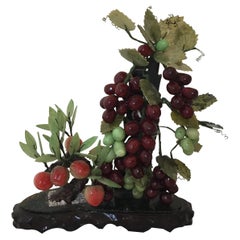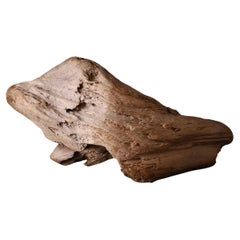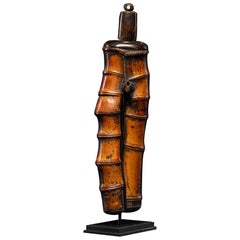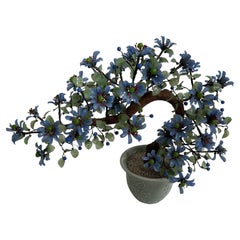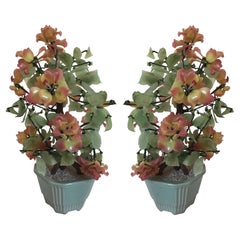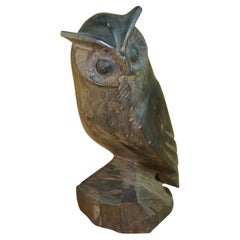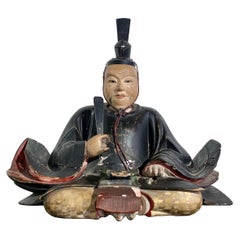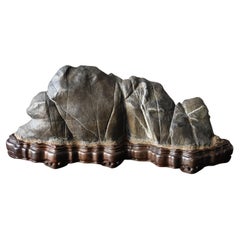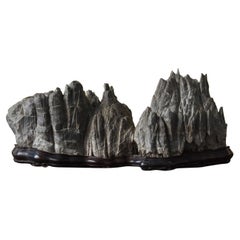Japanese Natural Specimens
to
1
17
1
3
14
1
4
8
3
1
7
7
1
10
7
7
5
3
6
2
13,882
1,029
795
769
640
Height
to
Width
to
18
18
18
1
Place of Origin: Japanese
Spiral6 Kenta Hirai Japanese Contemporary Bentwood Sculpture
By Studio Jig
Located in Shibuya-ku, Tokyo
Kenta Hirai created it with the technique "Free form lamination." This sculpture mixes free formed wood sculpture and branch. Wood materials are Yoshino Cedar...
Category
2010s Modern Japanese Natural Specimens
Materials
Wood
Bonsai 1980, Glass and Wood
Located in Ciudad Autónoma Buenos Aires, C
We have specialized in the sale of Art Deco and Art Nouveau and Vintage styles since 1982. If you have any questions we are at your disposal.
Pushing the button that reads 'View All ...
Category
1980s Mid-Century Modern Vintage Japanese Natural Specimens
Materials
Wood, Art Glass
Natural Sculptural Piece - Decorative Dynamic Old Sun Bleached Driftwood
Located in Fukuoka, JP
This stunning piece of old sun-bleached Japanese driftwood embodies the beauty of nature’s artistry. Shaped by time, wind, and water, it features an organic, sculptural form with a r...
Category
20th Century Japanese Natural Specimens
Materials
Wood
Antique Japanese Bamboo Kayakuire-Powder Flask , Edo Period.
Located in Leuven , BE
This artifact is an antique Kayakuire (火薬入れ), or gunpowder flask, a fascinating example of traditional Japanese craftsmanship. In feudal Japan, gunpowd...
Category
19th Century Antique Japanese Natural Specimens
Materials
Bamboo, Wood
Big Bonsai, Glass and Ceramic
Located in Ciudad Autónoma Buenos Aires, C
We have specialized in the sale of Art Deco and Art Nouveau and Vintage styles since 1982. If you have any questions we are at your disposal.
Pushing the button that reads 'View All From Seller'. And you can see more objects to the style for sale.
Why are there so many antiques in Argentina?
In the 1880 – 1940 there was a grate wave of immigration encouraged by the periods of war that were taking place.
1st World War took place between 1914 and 1918
2nd World War took place between 1939 and 1945
The immigrants options were New York or Buenos Aires. Tickets were cheap and in Buenos Aires they were welcomed with open arms, as it was a country where everything was still to be done.
Argentina was the country of new opportunities, labour was needed and religious freedom was assured, in many cases the of the family travel first until they were settled and then the rest of the family members join them.
In the immigrant museum “Ellis Island Immigrant Building” in New York you can se the promotional posters of the boats that would take them to a new life.
Between the years 1895 and 1896, Argentina had the highest DGP (gross domestic product) per capita in the world according to the Maddison Historical Statistics index, this situation arose due to the large amount of food being exported to European countries, which were at war.
The Argentinean ships left the port of Buenos Aires with food, but they returned with furniture, clothes and construction elements, (it´s common to see this the old buildings of the historic neighbourhood of San Telmo, the beams with the inscription “Made in England)”, as well as many markets that were built in Buenos Aires, such us the San Telmo Market, whose structure was brought by ship and afterwards assembled in 900 Defensa Street.
With the great influence of European immigrants living in the country, the children of the upper classes travelled to study in France, resulting in the inauguration of “La Maison Argentinienne”, on 27th of June 1928, in the international city of Paris, which hosted many Argentinians that were studying in Frace.
It´s the fourth house to be built after France, Canada and Belgium, being the first Spanish-speaking one. Still in place today (17 Bd Jourdan, 75014, Paris, France). Many of the children of these wealthy families who attended international art exhibitions, museums and art courses abroad, took a keen interest in the European style. This is why Buenos Aires was at the time referred as “The Paris of South America”.
Between the years 1890 and 1920 more than a hundred Palaces were built on Alvear Avenue the most exclusive avenue in Buenos Aires. Today some of these palaces have been transformed into museums, hotels and embassies.
In the year 1936, the Kavanagh building was inaugurated, it was the tallest reinforced concrete building in South America.
During 1994 the American Society of Civil Engineers distinguished it as an “international engineering milestone”, and it´s now considered a World Heritage of Modern Architecture.
At the time was common to hire foreign architects such as Le Corbusier, who visited Buenos Aires/Argentina in 1929 and in 1948 he drew up the blueprints for a house built in La Plata City (which was declared a World Heritage Site).
In 1947, the Hungarian architect Marcelo Breuer designed “Parador Ariston” in the seaside city of Mar del Plata. After an Argentinean student at Harvard University convinced him to come to Argentina. He worked on an urban development project in the Casa Amarilla, area of La Boca.
The Ukrainian architect, Vladimiro Acosta, arrives in Argentina in 1928 and worked as an architect until que moved to Brazil.
Antonio Bonet, a Spanish architect who worked with Le Corbusier in Paris, arrives in Argentina in 1937, where he carried out several architectural works and in 1938 designs the well-known BFK chair.
Andres Kálnay, of Hungarian origin, made around 120 architectural masterpieces, among which the former Munich brewery stands out, he even made the furniture’s design.
The German architect, Walter Gropius, director of the Bauhaus, lived in Argentina, where he wrote articles for “Sur” magazine and founded in Buenos Aires, an architectural firm with Franz Möller, who was also an architect, where he built two houses.
At the same time several famous designers decided to immigrate to Argentina, among them we can find the well-known French designer, Jean-Michel Frank, who arrived in the country in 1940 and also worked for the Rockefeller family.
Special pieces were made, which were sold exclusively in the country, such as the well-known German company “WMF”, who sold their products by catalogue, which were chosen by the ladies of High Society in the list of wedding gifts, as well as the pieces designed by Christofle.
The Swiss sculptor Alberto Giacometti, made special pieces for Argentinean mansions.
In 1904 the first Jansen branch outside Paris was established in Buenos Aires, as the Argentinean clientele demanded a large amount of furniture, from the end of the 19th Century to the mid-20th Century.
In 1970, the brand Rigolleau Argentina made pieces authorised by Lalique.
The brands Maple and Thompson also set up shop in the country.
The French plastic artist, Marcel Duchamp moved to Argentina in 1918-1919.
Glass signed Gallé, Charder, Leverre, Schneider, Muller and other French firms. They were bought in flower shops and were given to ladies with beautiful floral arrangements.
Some furniture manufacturers travelled to international fairs and bough the patterns to produce the furniture in Argentina, such as the furniture firm Englander and Bonta, who bought the patterns ins Italy.
It is worth mentioning that in Argentina we have the largest Community of Italians outside...
Category
1980s Mid-Century Modern Vintage Japanese Natural Specimens
Materials
Art Glass, Ceramic
Pair of Bonsai 1980, Glass and Ceramic
Located in Ciudad Autónoma Buenos Aires, C
We have specialized in the sale of Art Deco and Art Nouveau and Vintage styles since 1982. If you have any questions we are at your disposal.
Pushing the button that reads 'View All ...
Category
1980s Mid-Century Modern Vintage Japanese Natural Specimens
Materials
Art Glass, Ceramic
19th Century Signed Japanese Meiji Bronze Wave with Carrera Marble Sphere
Located in Los Angeles, CA
A wonderfully unique Meiji Bronze Wave - the details and techniques are very intricate. There are no missing pieces or damage. the piece is in very...
Category
Late 19th Century Meiji Antique Japanese Natural Specimens
Materials
Carrara Marble, Bronze
$2,880 Sale Price / set
20% Off
Pair of Bonsai, Glass and Ceramic, 1980
Located in Ciudad Autónoma Buenos Aires, C
We have specialized in the sale of Art Deco and Art Nouveau and Vintage styles since 1982. If you have any questions we are at your disposal.
Pushing the button that reads 'View All ...
Category
1980s Mid-Century Modern Vintage Japanese Natural Specimens
Materials
Ceramic, Art Glass
Big Yellow Bonsai, Glass and Ceramic
Located in Ciudad Autónoma Buenos Aires, C
We have specialized in the sale of Art Deco and Art Nouveau and Vintage styles since 1982. If you have any questions we are at your disposal.
Pushing the button that reads 'View All ...
Category
1980s Mid-Century Modern Vintage Japanese Natural Specimens
Materials
Ceramic, Art Glass
Bonsai Pink 1980, Glass and Wood
Located in Ciudad Autónoma Buenos Aires, C
We have specialized in the sale of Art Deco and Art Nouveau and Vintage styles since 1982. If you have any questions we are at your disposal.
Pushing the button that reads 'View All ...
Category
1980s Mid-Century Modern Vintage Japanese Natural Specimens
Materials
Art Glass, Wood
Wabi Sabi Natural Driftwood and Stone Sculpture, Japan
Located in Tokyo, Tokyo
Natural driftwood and stone sculpture from Japan. Very good vintage condition.
The beautiful form shaped by the nature. Wabi Sabi.
Category
20th Century Japanese Natural Specimens
Materials
Stone
Two Japanese Bronze Shells
Located in New York, NY
These charming bronze shells were cast in Japan in the 19th century. They lived for many years in the collection of the Paris artist Pierre Le-Tan. One of...
Category
19th Century Edo Antique Japanese Natural Specimens
Materials
Bronze
$9,000 / set
Bonsai Blue 1980, Glass and Ceramic
Located in Ciudad Autónoma Buenos Aires, C
We have specialized in the sale of Art Deco and Art Nouveau and Vintage styles since 1982. If you have any questions we are at your disposal.
Pushing the button that reads 'View All From Seller'. And you can see more objects to the style for sale.
Why are there so many antiques in Argentina?
In the 1880 – 1940 there was a grate wave of immigration encouraged by the periods of war that were taking place.
1st World War took place between 1914 and 1918
2nd World War took place between 1939 and 1945
The immigrants options were New York or Buenos Aires. Tickets were cheap and in Buenos Aires they were welcomed with open arms, as it was a country where everything was still to be done.
Argentina was the country of new opportunities, labour was needed and religious freedom was assured, in many cases the of the family travel first until they were settled and then the rest of the family members join them.
In the immigrant museum “Ellis Island Immigrant Building” in New York you can se the promotional posters of the boats that would take them to a new life.
Between the years 1895 and 1896, Argentina had the highest DGP (gross domestic product) per capita in the world according to the Maddison Historical Statistics index, this situation arose due to the large amount of food being exported to European countries, which were at war.
The Argentinean ships left the port of Buenos Aires with food, but they returned with furniture, clothes and construction elements, (it´s common to see this the old buildings of the historic neighbourhood of San Telmo, the beams with the inscription “Made in England)”, as well as many markets that were built in Buenos Aires, such us the San Telmo Market, whose structure was brought by ship and afterwards assembled in 900 Defensa Street.
With the great influence of European immigrants living in the country, the children of the upper classes travelled to study in France, resulting in the inauguration of “La Maison Argentinienne”, on 27th of June 1928, in the international city of Paris, which hosted many Argentinians that were studying in Frace.
It´s the fourth house to be built after France, Canada and Belgium, being the first Spanish-speaking one. Still in place today (17 Bd Jourdan, 75014, Paris, France). Many of the children of these wealthy families who attended international art exhibitions, museums and art courses abroad, took a keen interest in the European style. This is why Buenos Aires was at the time referred as “The Paris of South America”.
Between the years 1890 and 1920 more than a hundred Palaces were built on Alvear Avenue the most exclusive avenue in Buenos Aires. Today some of these palaces have been transformed into museums, hotels and embassies.
In the year 1936, the Kavanagh building was inaugurated, it was the tallest reinforced concrete building in South America.
During 1994 the American Society of Civil Engineers distinguished it as an “international engineering milestone”, and it´s now considered a World Heritage of Modern Architecture.
At the time was common to hire foreign architects such as Le Corbusier, who visited Buenos Aires/Argentina in 1929 and in 1948 he drew up the blueprints for a house built in La Plata City (which was declared a World Heritage Site).
In 1947, the Hungarian architect Marcelo Breuer designed “Parador Ariston” in the seaside city of Mar del Plata. After an Argentinean student at Harvard University convinced him to come to Argentina. He worked on an urban development project in the Casa Amarilla, area of La Boca.
The Ukrainian architect, Vladimiro Acosta, arrives in Argentina in 1928 and worked as an architect until que moved to Brazil.
Antonio Bonet, a Spanish architect who worked with Le Corbusier in Paris, arrives in Argentina in 1937, where he carried out several architectural works and in 1938 designs the well-known BFK chair.
Andres Kálnay, of Hungarian origin, made around 120 architectural masterpieces, among which the former Munich brewery stands out, he even made the furniture’s design.
The German architect, Walter Gropius, director of the Bauhaus, lived in Argentina, where he wrote articles for “Sur” magazine and founded in Buenos Aires, an architectural firm with Franz Möller, who was also an architect, where he built two houses.
At the same time several famous designers decided to immigrate to Argentina, among them we can find the well-known French designer, Jean-Michel Frank, who arrived in the country in 1940 and also worked for the Rockefeller family.
Special pieces were made, which were sold exclusively in the country, such as the well-known German company “WMF”, who sold their products by catalogue, which were chosen by the ladies of High Society in the list of wedding gifts, as well as the pieces designed by Christofle.
The Swiss sculptor Alberto Giacometti, made special pieces for Argentinean mansions.
In 1904 the first Jansen branch outside Paris was established in Buenos Aires, as the Argentinean clientele demanded a large amount of furniture, from the end of the 19th Century to the mid-20th Century.
In 1970, the brand Rigolleau Argentina made pieces authorised by Lalique.
The brands Maple and Thompson also set up shop in the country.
The French plastic artist, Marcel Duchamp moved to Argentina in 1918-1919.
Glass signed Gallé, Charder, Leverre, Schneider, Muller and other French firms. They were bought in flower shops and were given to ladies with beautiful floral arrangements.
Some furniture manufacturers travelled to international fairs and bough the patterns to produce the furniture in Argentina, such as the furniture firm Englander and Bonta, who bought the patterns ins Italy.
It is worth mentioning that in Argentina we have the largest Community of Italians outside...
Category
1980s Mid-Century Modern Vintage Japanese Natural Specimens
Materials
Art Glass, Ceramic
Japanese inspired 4 natural Object sculptures nautiucal and forest material.
Located in Rümmingen, BW
Set of 4 Minimalist Nature-Inspired Sculptures on Wood Bases in a Japanese style.
This set of four unique sculptures combines natural and crafted elements, each mounted on a tall, ...
Category
Mid-20th Century Japonisme Japanese Natural Specimens
Materials
Shell, Wood, Driftwood, Pine
Sculptural Japanese Keyaki Wood Partition in the Style of Nakashima
By George Nakashima
Located in Los Angeles, CA
Sculptural Japanese keyaki wood partition in the style of Nakashima.
Category
1960s Organic Modern Vintage Japanese Natural Specimens
Materials
Hardwood
Sculptural Japanese Keyaki Wood Partition in the Style of Nakashima
By George Nakashima
Located in Los Angeles, CA
Sculptural Japanese keyaki wood partition in the style of Nakashima.
Category
1960s Organic Modern Vintage Japanese Natural Specimens
Materials
Hardwood
Sculptural Japanese Keyaki Wood Partition in the Style of Nakashima
By George Nakashima
Located in Los Angeles, CA
Sculptural Japanese keyaki wood partition in the style of Nakashima.
Category
1960s Organic Modern Vintage Japanese Natural Specimens
Materials
Hardwood
Japanese Iron Vase with Inlaid Silver and Gold by Ueda Hiroshi
Located in Stamford, CT
A cylindrical iron Ikebana vase with silver and gold spiral design depicting stream. The vase was made by Ueda Hiroshi and is signed Hiroshi. The box come...
Category
1970s Showa Vintage Japanese Natural Specimens
Materials
Iron
Related Items
Japanese Owl Hand Carved Rosewood Sculpture
Located in Douglas Manor, NY
3-983 Japanese owl hand carved rosewood sculpture.
Category
1930s Vintage Japanese Natural Specimens
Materials
Hardwood
Japanese Carved and Lacquered Wood Shogun, Edo Period, 19th Century, Japan
Located in Austin, TX
An unusual Japanese carved wood, lacquer, and gilt decorated portrait sculpture of a shogun, Edo Period, early 19th century, Japan.
The unidentified shogun (possibly Tokugawa Iey...
Category
Mid-19th Century Edo Antique Japanese Natural Specimens
Materials
Wood, Lacquer
$2,800
H 10.25 in W 10.5 in D 7.5 in
Pair of Japanese Edo Period Musha Ningyo Courtier Dolls
Located in Austin, TX
Two exquisite Japanese musha ningyo dolls, crafted as courtiers, Edo Period, early 19th century, Japan.
The older man can be identified as the h...
Category
Early 19th Century Edo Antique Japanese Natural Specimens
Materials
Shell, Brocade, Silk, Glass, Wood, Paint, Paper
Antique Japanese Inro by Shigehide Edo Period
Located in Atlanta, GA
This exquisite four-case lacquered inro was dated to the latter part of 18th century to early 19th century (Edo period) and made by Shigehide. The opposite sides of the inro together features a lavish flower arrangement in a bamboo basket (ikebana). The detailed craftmanship was a true pleasure to behold. Mostly Takamaki-e (high relief) were used to texturize the delicate petals of the chrysanthemums, on which different shades of gold were used to create contrast. Raden (mother of pearl) shells were also used to highlight some leaves, rendering the piece an interesting balance of color and material. The interior was completed in a mottled gold finish. It was signed Shigehide on the bottom with a Kao. There is a small carved rabbit ojime bead...
Category
Late 18th Century Japonisme Antique Japanese Natural Specimens
Materials
Wood, Lacquer
Sculptural Driftwood with Fossil Agate Coral, Crystal Points, and Fossil Shells
By Interi
Located in Dublin, Dalkey
Sculptural driftwood with fossil agate coral, crystal points, and fossil shells.
Driftwood is wood that has been washed onto a shore of a large body ...
Category
21st Century and Contemporary Organic Modern Japanese Natural Specimens
Materials
Agate, Coral, Rock Crystal
$1,875 Sale Price
25% Off
H 20 in W 15 in D 7 in
Japanese antique wood carved Buddha/1800s/late Edo period/folk Buddha
Located in Sammu-shi, Chiba
This is a wooden Jizo Bodhisattva statue made in the late Edo period in Japan.
It is thought that they were not carved by Buddhist sculptors living in central cities such as Kyoto or...
Category
19th Century Edo Antique Japanese Natural Specimens
Materials
Cypress
$800
H 7.52 in W 6.82 in D 4.45 in
Japanese antique two-piece stone statue of a monk/God of the road/Edo period
Located in Sammu-shi, Chiba
We have a rare stone Buddha in stock.
This is a small twin-figure stone carving made in the early to middle Edo period (1600–1800). It features two standing monk-like deities side b...
Category
18th Century Edo Antique Japanese Natural Specimens
Materials
Stone
$700
H 9.06 in W 3.94 in D 2.96 in
Japanese Bronze Koi Fish Sculpture
Located in Houston, TX
Japanese Bronze Koi Fish Sculpture.
This well executed Japanese bronze Koi or Goldfish sculpture has a beautiful patinated verdigris finish and will...
Category
1950s Meiji Vintage Japanese Natural Specimens
Materials
Bronze
Japanese antique Kannon stone statue/Edo period/Buddhist ornament
Located in Sammu-shi, Chiba
This is a stone statue of Kannon Bosatsu (the Bodhisattva of Compassion), believed to have been made in Japan during the mid to late Edo period (late 18th century onward). The materi...
Category
Early 19th Century Edo Antique Japanese Natural Specimens
Materials
Stone
$1,000
H 18.71 in W 6.89 in D 5.63 in
Japanese Owl Hand Carved Rosewood Sculpture
Located in Douglas Manor, NY
3-983 Japanese owl hand carved rosewood sculpture.
Category
1930s Vintage Japanese Natural Specimens
Materials
Hardwood
Large Highly Decorative Old Natural Sea Shell #4
Located in Opa Locka, FL
Beautiful Large Natural Highly Decorative Sea Shell. Great for decorating! I purchased a collection of Sea Shells from a antique store in Newport.
Category
1940s Mid-Century Modern Vintage Japanese Natural Specimens
Materials
Shell
Ettore Sottsass Y Limited Edition Vase in Wood and Murano Glass for Flowers
By Ettore Sottsass, Design Gallery Milano
Located in Barcelona, Barcelona
Y vase made for the collection of twenty-seven woods for Chinese artificial flowers vase by Ettore Sottsass,
Edited by Design Gallery Milano, 1995.
Limited edition of 12 numbered pi...
Category
1990s Modern Japanese Natural Specimens
Materials
Glass, Wood
$11,431
H 19.3 in W 12.6 in D 9.06 in
Previously Available Items
Japanese Old Appreciation Stone/Scholars Stone/Mountain Landscape Figurine
Located in Sammu-shi, Chiba
I would like to introduce some wonderful stones mined in Japan.
This is probably a stone produced in Shizuoka Prefecture or Wakayama Prefecture.
It is believed that the quarrying a...
Category
20th Century Showa Japanese Natural Specimens
Materials
Limestone
H 6.78 in W 16.15 in D 5.6 in
Japanese "Suiseki" Mountain View Scholar's Old Stone/ Amazing Rocky Landscape
Located in Sammu-shi, Chiba
This is a stone mined in Japan.
Not only in China but also in Japan from ancient times, rocks in the mountains have been shaved and stones for ...
Category
Mid-20th Century Other Japanese Natural Specimens
Materials
Limestone
H 6.7 in W 15.75 in D 6.19 in
Japanese "Suiseki" Mountain View Scholar's Old Stone/ Mountain Scenery
Located in Sammu-shi, Chiba
This is a stone mined in Japan.
Not only in China but also in Japan from ancient times, rocks in the mountains have been shaved and stones for ...
Category
Early 20th Century Other Japanese Natural Specimens
Materials
Limestone
Old Japanese Beautiful Scholar's Stone / "Seigaku-Stone" /Mountain-Shaped
Located in Sammu-shi, Chiba
This is a stone mined in Japan.
Not only in China but also in Japan from ancient times, rocks in the mountains have been shaved and stones for ...
Category
Mid-20th Century Showa Japanese Natural Specimens
Materials
Limestone
H 5.71 in W 19.69 in D 9.18 in
Suiseki Rock-Stone on Wooden Base
Located in Kastrup, DK
Japanese Scholar's Stone resting on a wooden fitted carved base.
An extraordinary specimen created by nature millions of years ago. This is a stone mi...
Category
20th Century Other Japanese Natural Specimens
Materials
Stone
Suiseki Rock-Stone on a Base of Wood, Japan
Located in Kastrup, DK
Suiseki rock-stone on a hardwood base.
The stone has an exciting expression of flowers.
Suiseki in Japanese, Scholer's Rock in Chinese and Suseok in Korean.
Asian Zen tradition ...
Category
Early 20th Century Other Japanese Natural Specimens
Materials
Stone
Flower Wall Art 02 Norihiko Terayama
By Norihiko Terayama
Located in Shibuya-ku, Tokyo
Title: Artificial and dried flowers that were arranged
Unique wall art by Norihiko Terayama. Small cut out piece of artificial flowers and dried flower...
Category
2010s Modern Japanese Natural Specimens
Materials
Wood, Acrylic
Spiral5 Kenta Hirai Japanese Contemporary Bentwood Sculpture
By Studio Jig
Located in Shibuya-ku, Tokyo
Kenta Hirai created it with the technique "Free form lamination." This sculpture mixes free formed wood sculpture and branch. Wood material is...
Category
2010s Modern Japanese Natural Specimens
Materials
Wood
Masatoya Kishi 'Kuki' Composition Organic Modern Sculpture Signed
By Kuki
Located in North Miami, FL
This fantastic organic modern signed Masatoya Kishi composition sculpture is a sandy tan color and is a limited edition of 75/100 and signed Kuki. That is how this wonderful Japanese...
Category
1980s Organic Modern Vintage Japanese Natural Specimens
Materials
Cast Stone, Composition
Japanese Polished Spirit Stone in the Shape of a Mountain Range
Located in Hudson, NY
Japanese polished spirit stone in the shape of a mountain range, archaic polished stone with beautiful veined green color simulating a mountain range, set...
Category
Early 1900s Meiji Antique Japanese Natural Specimens
Materials
Stone
19th Century Japanese Stone Weight
Located in Chicago, IL
A wonderful 19th century Japanese stone weight with a forged iron handle. The perfect doorstop or weight for the balloons at your next fête.
Category
19th Century Antique Japanese Natural Specimens
Materials
Stone, Iron
Kazuo Kadonaga Peeled Wood Log 'Wood No. 5'
Located in Los Angeles, CA
Japanese artist Kazuo Kadonaga: peeled wood log, Wood No. 5, 1981, Signed
Provenance: Space Gallery.
Category
1980s Modern Vintage Japanese Natural Specimens
Materials
Wood
Recently Viewed
View AllMore Ways To Browse
Tabletop Bookcase
Tessellated Chest
Thai Deity
Thai Monk
Three Hands Bowl
Tiffany Art Glass Signed
Tin Bank
Transistor Vintage
Triangle Glass Bowl
Two Over Three Chest
Unique Furniture Makers
Unusual Display Cabinet
Used Bonsai Pots
Used Glass Display Counter
Used Glass Display Counters
Used Ice Chests
Used Shaving Brush
Usm Haller Vintage
